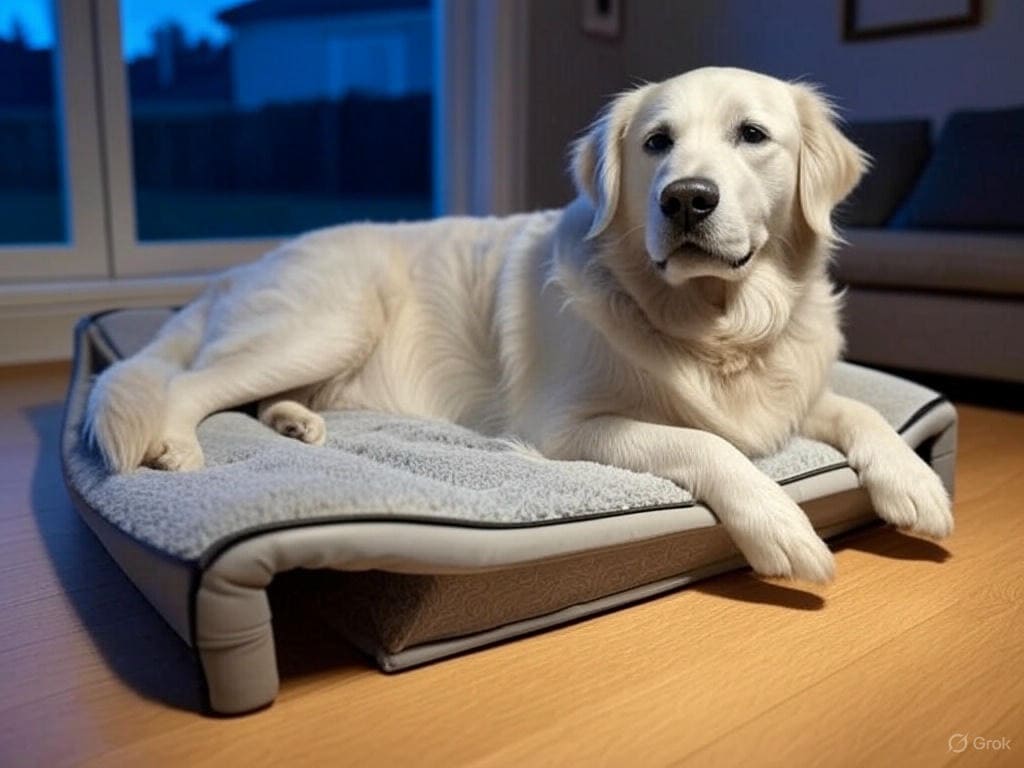Introduction
Arthritis is a common challenge for senior dogs, causing joint pain, stiffness, and reduced mobility that can impact their quality of life. Adapting the care routine for senior dogs with arthritis is essential to ensure comfort, support health, and maintain happiness. From tailored exercise and home modifications to nutrition and emotional care, small changes can make a significant difference.
This guide provides practical tips to help you create a supportive routine, enhancing your dog’s well-being. For related strategies, explore our guide on 5 exercises to improve flexibility in senior dogs to boost mobility safely.
Understanding Arthritis in Senior Dogs
Arthritis, an inflammatory joint condition, affects many senior dogs due to cartilage wear, trauma, or genetics, targeting areas like hips, knees, and spines. It leads to:
- Symptoms: Stiffness, difficulty standing, reluctance to climb stairs, slow walking, or behavioral changes like reduced playfulness.
- Impact: Pain and limited mobility can lower activity levels, causing muscle loss and emotional distress.
Adapting your dog’s care routine—through exercise, diet, and environmental changes—helps manage symptoms and supports a comfortable, active life. Veterinary guidance ensures these adjustments align with your dog’s specific needs, maximizing their quality of life.
Recognize Your Dog’s Specific Needs
Each senior dog with arthritis has unique limitations, shown through signs like:
- Slow movements or stiffness after rest
- Hesitation to stand, walk, or climb
- Hunched posture or reduced interest in play
Observing these cues helps tailor care. For example, replace long walks with shorter, frequent outings to maintain mobility without strain. At home, place food, water, and beds in easily accessible spots to minimize effort. Regular monitoring ensures the routine evolves with your dog’s comfort and capabilities, fostering independence and well-being.
Gentle and Consistent Exercise
Exercise is vital for dogs with arthritis, strengthening muscles, improving circulation, and reducing stiffness. Gentle activities ensure benefits without joint stress.
- Short, Frequent Walks: Walk for 10–15 minutes, 2–3 times daily, on soft surfaces like grass. Let your dog set the pace and include breaks.
- Supervised Swimming: Water-based exercise eases joint pressure while promoting movement. Use warm water (82–90°F or 28–32°C) and a life vest for safety. Learn more in our guide on hydrotherapy: a safe exercise for dogs.
- Tips:
- Start slowly and increase activity gradually.
- Watch for fatigue or limping, pausing if needed.
Consistent, low-impact exercise enhances mobility and comfort, keeping your dog active and engaged.
Home Environment Adjustments
A safe, comfortable home supports your arthritic dog’s mobility and rest.
- Orthopedic Beds: Provide cushioned, supportive beds in quiet, accessible areas to relieve joint pressure and improve sleep.
- Non-Slip Surfaces: Use rugs or runners on tile or hardwood to prevent slips, boosting confidence in movement.
- Ramps: Install ramps for furniture or car access, reducing the need for painful jumps.
These modifications create a joint-friendly environment, promoting independence and safety. For example, a ramp to a favorite couch can restore your dog’s ability to relax comfortably.
Proper Nutrition and Joint Supplements
A balanced diet supports senior dogs with arthritis, addressing slower metabolisms and joint health needs.
- Healthy Weight: Excess weight strains joints, so feed nutrient-rich, portion-controlled meals to maintain an ideal weight.
- Joint Supplements:
- Omega-3 Fatty Acids: Reduce inflammation and ease pain.
- Glucosamine and Chondroitin: Support cartilage repair and mobility.
- Tips: Consult a vet to choose safe, effective supplements tailored to your dog’s condition.
Proper nutrition and supplements enhance joint health, complementing physical care for lasting comfort.
Regular Massage and Stretching
Massage and stretching relieve muscle tension, improve circulation, and boost flexibility, enhancing your dog’s comfort and bond with you.
- Massage: Use light, circular motions on shoulders, back, and thighs to relax muscles and reduce stiffness. Perform 2–3 times weekly.
- Stretching: Gently extend front and back legs to improve range of motion. Stop if your dog shows discomfort. See more techniques in our guide on 5 simple stretches for senior dogs.
- Tips: Schedule during calm moments, like post-walk or bedtime, for relaxation.
These sessions promote physical relief and emotional connection, making care a nurturing experience.
Veterinary Monitoring and Physical Therapy
Regular veterinary care ensures effective arthritis management.
- Monitoring: Vets assess joint health and adjust care plans, recommending medications or supplements as needed.
- Physical Therapy: Therapists use techniques like hydrotherapy, massage, or guided exercises to improve mobility and reduce pain.
- Tips: Schedule check-ups every 6–12 months or if symptoms change, ensuring routines remain safe and beneficial.
Professional support maximizes your dog’s comfort and vitality, tailoring care to their evolving needs.
Emotional Comfort and Mental Well-Being
Emotional health is crucial for arthritic senior dogs, as pain can cause stress or withdrawal.
- Mental Stimulation: Offer low-effort toys like treat puzzles or scent games to keep your dog engaged.
- Companionship: Spend quality time with affection, gentle petting, or a soothing voice to reduce anxiety.
- Adapted Play: Use slow-paced fetch or gentle interactive games to match physical limits, fostering joy.
These efforts maintain emotional balance, reinforcing your dog’s sense of security and happiness.
Frequently Asked Questions
How often should I exercise my arthritic senior dog?
Aim for 2–3 short sessions (10–15 minutes) daily, like walks or stretching, adjusting based on your dog’s comfort. Consult a vet for guidance.
Can I make home adjustments on a budget?
Yes, use affordable rugs for traction, DIY ramps from sturdy boards, or repurpose cushions as beds. Focus on accessibility and safety.
What if my dog seems depressed due to arthritis?
Increase companionship, try gentle play, or consult a vet for pain management or behavioral support to boost mood.
Conclusion
Adapting the care routine for senior dogs with arthritis enhances their comfort and quality of life. Through gentle exercise, home modifications, proper nutrition, massage, veterinary care, and emotional support, you can help your dog thrive despite arthritis. Observe their signals, adjust as needed, and work with a veterinarian to ensure ongoing care. With love and attention, your senior dog can enjoy a happy, active life. Share your care tips in the comments!

